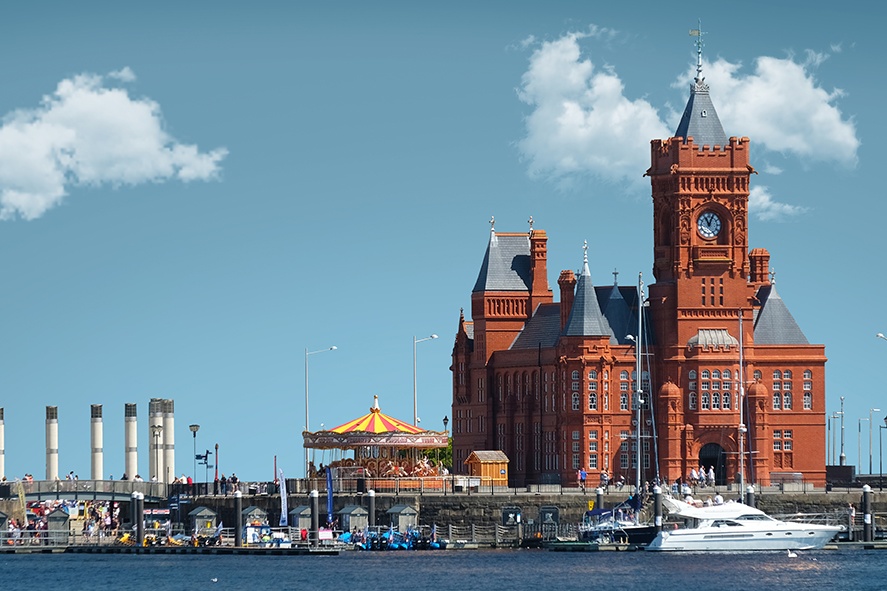To celebrate 25 years of National Lottery funding, Wales Millennium Centre – which was part funded by the National Lottery – has released an image showing how Cardiff Bay’s skyline would look if the Centre didn’t exist.
This reflects a startling UK-wide campaign in which illusionist Julius Dein has made the iconic Angel of the North ‘disappear’ to highlight how our landscapes would look if funding didn’t exist.
The National Lottery and the Arts Council of Wales is calling upon its projects to post images and captions on social media of what is iconic to them in their community that wouldn’t be here without that funding. From local galleries to painting clubs. If it’s iconic to a community, groups are being encouraged to post.
The images highlight some of the UK’s best-known arts buildings and projects including Wales Millennium Centre, The Angel of the North, The Lowry, The Tate Modern and many more.
The National Lottery fund contributed £31.7 million towards the building of Wales Millennium Centre. Wales’s home for the arts, which celebrates its own 15th birthday next month, is one the most iconic buildings in Wales – attracting over 1.5 million people each year and contributing over £50 million a year to the Welsh economy.
The site covers a total area of 4.7 acres and comprises the 1,800 seat Donald Gordon theatre, the BBC Hoddinott Hall, two smaller performance spaces – the Weston Studio and Ffresh – and eight resident organisations including the National Orchestra of Wales, the Welsh National Opera and the Urdd.
Nick Capaldi, Chair of The Wales National Lottery Forum and the Chief Executive of the Arts Council of Wales, said:
“The National Lottery’s players have literally helped transform the arts landscape in Wales. Over the last 25 years, we have funded over 13,000 projects throughout Wales and distributed £287m of National Lottery funding. The money has helped to transform arts buildings in Wales, creating a network of landmark buildings the length and breadth of the nation. The funding has also been used – and continues to be used – to support artists and organisations to make new and exciting work for people across the country.”
Graeme Farrow, Artistic Director of Wales Millennium Centre said:
“Wales Millennium Centre has been a National Lottery success story and we are extremely grateful for their support. We hope that this campaign helps raise awareness that The National Lottery has a hugely positive impact on the arts, and that the cultural landscape of the nation is much richer thanks to lottery funding”.
Antony Gormley’s Angel of the North is one the UK’s most famous pieces of public modern art, seen by 90,000 people every day. The artwork was erected on 15 February 1998 and over 70% of the total cost – £584,000 – came from National Lottery funding. In the video released today, Julius Dein shocks locals by making the iconic statue disappear, highlighting how different the landscape of the UK would look without the National Lottery.
Built to withstand winds of over 100mph and weighing an incredible 100 tonnes, Antony Gormley’s Angel of the North gives the appearance of being immovable as it looks out over Gateshead and the North East. In the video released today, Julius Dein works his trickery to suddenly leave the landscape bare of Gormley’s masterpiece, to the shock of locals who witnessed the illusion live, and his 6 million Instagram followers.
Julius Dein said:
“I am delighted to be working with The National Lottery for their 25th birthday in raising awareness for all the iconic and community art projects they have supported and funded over the last 25 years. Antony Gormley’s The Angel of the North is iconic and is the ephemeral symbol of the north which celebrates the roots of the people that live here. I have created this illusion with The National Lottery to raise awareness of how bare the UK’s art landscape would be without this funding, and we shouldn’t take that for granted.”
The stunt comes as new research from The National Lottery showed that creativity forms a big part of lives across the UK. A third (34%) of those surveyed currently take part in creative activities in their spare time, with a further 43% saying they would like to do more. When asked how it made them feel, 57% said they felt happier after taking part in creative activities with over half (56%) claiming to feel more relaxed, and two in five (41%) saying that creative activity helped them feel mentally healthier.
Over £5 billion of National Lottery funding has been invested in theatre, music, dance, literature and visual arts projects since 1994. Around £6 million is awarded by The National Lottery to UK arts projects every week. Forty percent of the population visit museums and galleries, including 1,400 art galleries helped by National Lottery funding.
Sources
DCMS database - Search: Good Cause Area: Arts
TNL Annual Results: £30M pw for Good Causes, 20% for Arts

